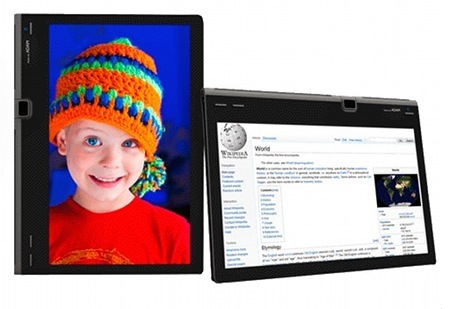Pixel Qi touts new transflective displays
Oct 7, 2011 — by LinuxDevices Staff — from the LinuxDevices Archive — 5 viewsPixel Qi announced two new transflective liquid crystal displays, promoted as being viewable in bright sunlight and providing devices with a significant power savings. They include a seven-inch screen with a resolution of 1024 x 600 pixels, and a 10-inch, 1280 x 800 screen that provides power even when its backlight is completely turned off, according to the company.
Pixel Qi displays, promised since June 2009, operate both in a standard backlit mode and a reflective mode, the latter allowing illumination to be supplied solely by the sun or other ambient lighting. As a result, it's said, Pixel Qi screens can consume 80 percent less power than standard displays.
Unfortunately for sun worshipers, the screens' journey to market has been a protracted one, as we review later in this story. (In brief, the panels have been generally available only to do-it-yourselfers or to purchasers of the Notion Ink Adam tablet.)
![]() In an Oct 6. blog posting, Mary Lou Jepsen (pictured), co-founder and CEO of Pixel Qi, writes, "I'm often asked how Pixel Qi is doing and when our products will be widely available. I'd like to report that over 3 million people are already using my screens, and we are now ramping into even higher volumes."
In an Oct 6. blog posting, Mary Lou Jepsen (pictured), co-founder and CEO of Pixel Qi, writes, "I'm often asked how Pixel Qi is doing and when our products will be widely available. I'd like to report that over 3 million people are already using my screens, and we are now ramping into even higher volumes."
Jepsen adds that Pixel Qi will be introducing two new products "into mass production in the coming months": a seven-inch, 1024 x 600 screen, and a 10-inch 1280 x 800 pixel screen that provides color even when its backlight is completely off. (As we explain later, previously released Pixel Qi screens sacrificed color when in their fully reflective mode.)
Pixel Qi announced Sept. 12 that its second (series "B") investment round had concluded thanks to funding — whose amount was undisclosed — provided by 3M's New Ventures division. Jepsen stated then that the financing "will play a key role in enabling Pixel Qi to develop its product offerings into volume consumer markets as well as digital signage and touch applications."
Background
Pixel Qi (pronounced "Pixel Chee"), which describes itself as a "fabless developer of a new class of screens," was a spinoff from OLPC (One Laptop Per Child), where Jepsen was said to have invented the XO-1 laptop's sunlight-readable display technology. The technology allows a portable computer's screen to be switched from a standard, backlit color mode to a monochrome reflective mode, saving power and allowing the device to be used even in direct, strong sunlight.
Pixel Qi first showed off screens based on an evolved version of this technology at the 2009 Computex show in Taiwan, at which time it claimed the displays would be available in netbooks later in the year. The company also said that production would have reached "hundreds of thousands a month" by early 2010.

Notion Ink's Adam
None of that transpired, and, as we've noted, the only Pixel Qi-equipped device to achieve any prominence was the Adam, an Android-based tablet from India-based startup Notion Ink. (An early version of the Adam was shown at the January 2010 Consumer Electronics Show (CES), but the device only began shipping at the beginning of this year.)
Pixel Qi says that unlike the electrophorescent displays already offered by E Ink Corporation, or the Mirasol displays mooted by Qualcomm's MEMS (micro-electro-mechanical systems) division, its screens use conventional LCD technology. While this fact limits the power savings the devices can achieve, it was touted as allowing manufacturing partners to ramp up quickly using existing production lines.
Given that, the ongoing delays frustrated even steadfast supporters of Pixel Qi's technology. Jepsen admitted in an April 2010 blog entry that "our initial manufacturing partner did get slowed down in the midst of the economic crisis," but added that Pixel Qi would reward the faithful by releasing kits allowing do-it-yourselfers to install the screens on their netbooks.
In July 2010, the company made a 10-inch screen available to the DIY community through O'Reilly Media's Make magazine and its online DIY store Maker Shed. Replacing a netbook's existing display with a Pixel Qi screen will likely void any warranty and is "a DIY project at your own risk," Jepsen warned. But, she claimed, "changing the screen of your netbook is easy; the process takes about five to ten minutes using a small screwdriver."
According to Maker Shed, the kits were guaranteed to work only with two netbooks, the Samsung N130 and Lenovo S10-2. A Make video showed the PQ 3Qi-01 being installed in an Acer netbook, and described the process as being "only slightly more complicated than changing a light bulb."
Last February, meanwhile, Laguna Nigel, Calif.-based Clover Systems began offering its Windows-based Sunbook netbook retrofitted with a Pixel Qi sceen. Thanks to the dual-mode display the netbook can be used anywhere from pitch darkness to the brightest sunlight, the company says.
Jonathan Angel can be reached at [email protected] and followed at www.twitter.com/gadgetsense.
This article was originally published on LinuxDevices.com and has been donated to the open source community by QuinStreet Inc. Please visit LinuxToday.com for up-to-date news and articles about Linux and open source.